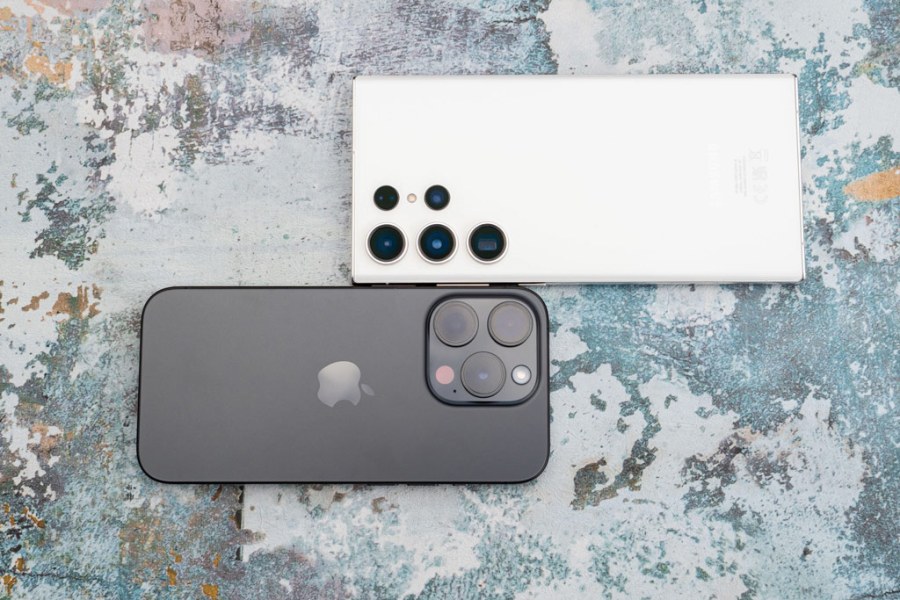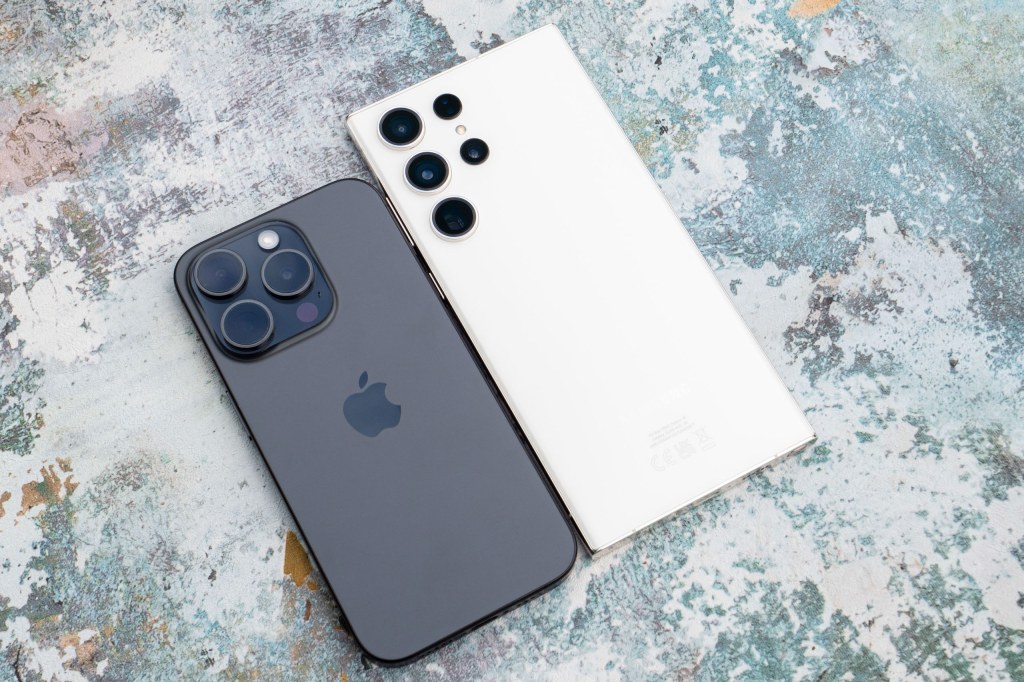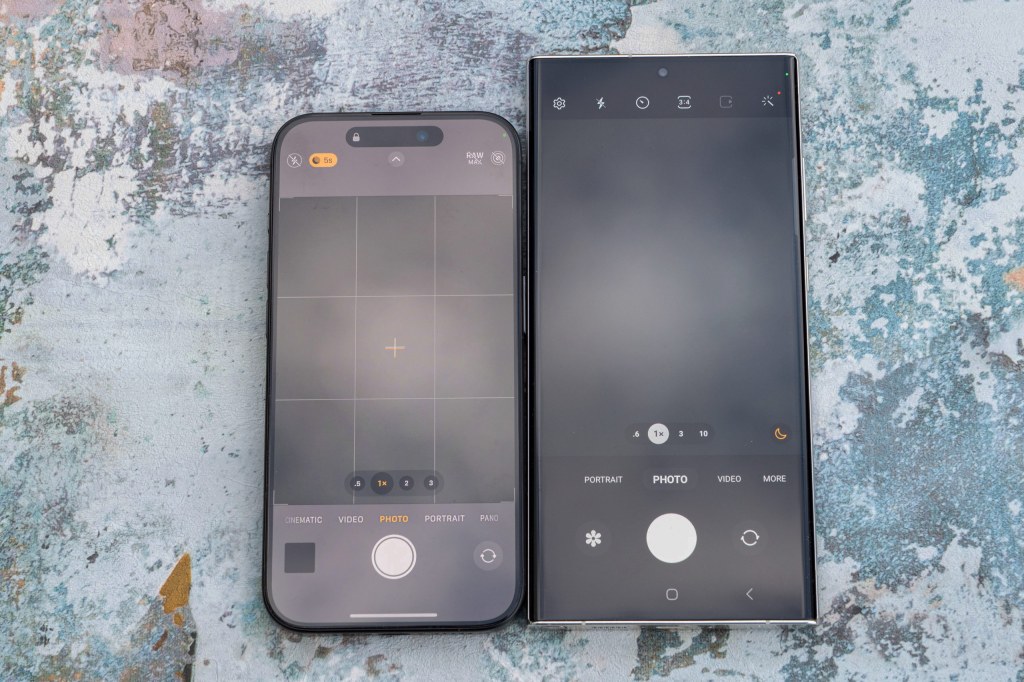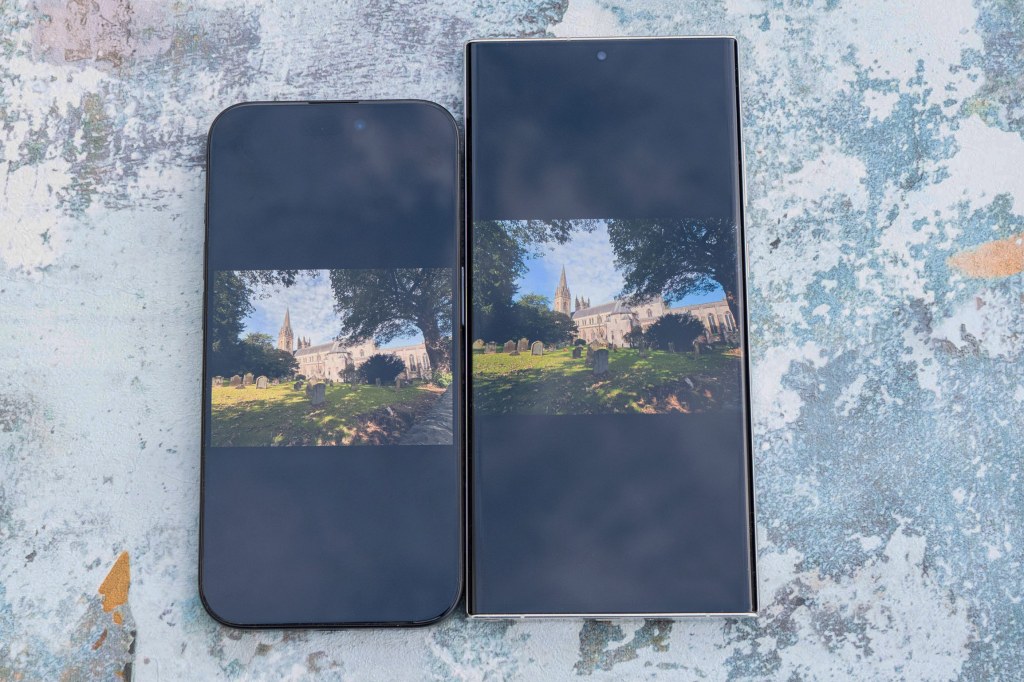If you’re looking for the best smartphone for photography, chances are good that you’ll perhaps be thinking about either an iPhone or a Samsung – they dominate the market. I tested the iPhone 15 Pro vs the Samsung Galaxy S23 Ultra to find out which could be the best choice for a camera phone.
Our current king of the camera phone is the Samsung S23 Ultra, which in our review we found offered fantastic performance across a range of specifications. But the one drawback it has – depending on your perspective – is just how big it is, which can make it a little bit unwieldy.
The obvious main competitor for the S23 Ultra is the iPhone 15 Pro Max – indeed we have already compared those two. But what about if you don’t want the big size, but still want lots of pro specs – that’s where the standard size of the iPhone 15 Pro comes in. With that, you get a much smaller phone, without losing very much of what makes it particularly appealing to photographers.
So, let’s find out whether the extra large screen size of the of S23 Ultra is worth buying over the smaller iPhone 15 Pro….
iPhone 15 Pro vs Samsung Galaxy S23 Ultra: Camera specs
Both the iPhone 15 Pro and the Samsung Galaxy S23 Ultra are fairly similar to their respective predecessors in terms of camera setups, but there are some notable differences between the two models.
With the iPhone 15 Pro we have a triple-lens setup which includes a standard (1x, 48MP sensor, 24mm equivalent, f/1.78), an ultrawide (0.5x, 12MP sensor, 13mm equivalent, f/2.2) and a telephoto (3x,12 MP sensor, 77mm equivalent, f/2.8) lens – the standard “Pro” doesn’t benefit from the 5x optic of the iPhone 15 Pro Max.
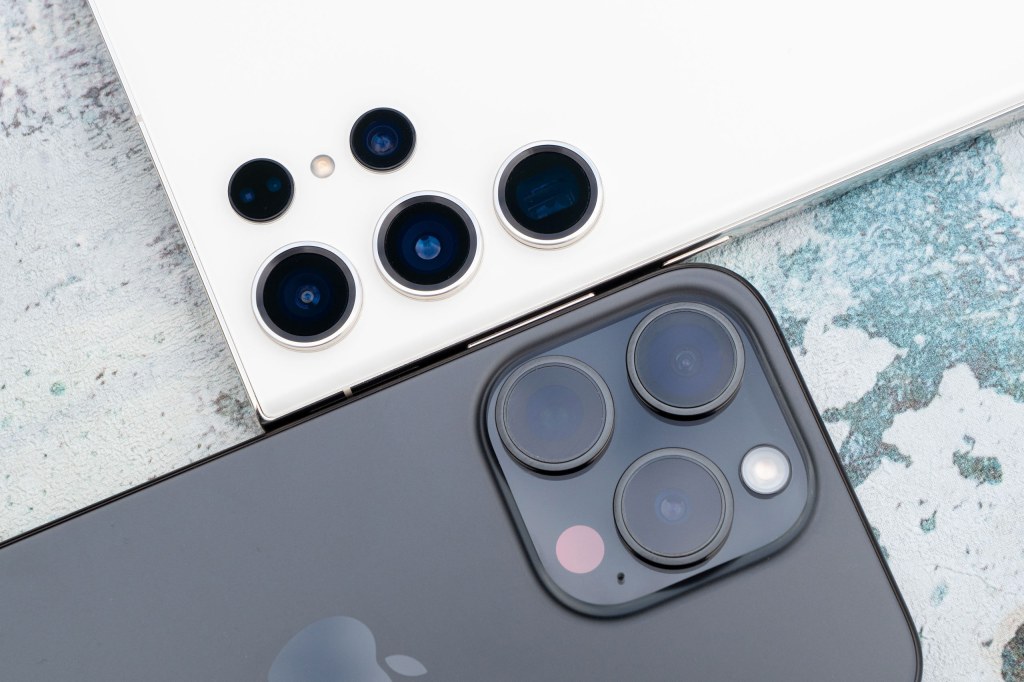
The Samsung S23 Ultra has four lenses giving up to 10x optical zoom, compared to the iPhone 15 Pro’s three lenses (3x optical zoom)Image credit: Amy Davies
For the S23 Ultra, there’s four lenses – something which isn’t widely used across the smartphone industry – and gives you lots of extra flexibility for zooming. So, you get a standard (1x, 200MP sensor, 24mm equivalent, f/1.7), ultrawide (0.6x, 12MP sensor, 13mm equivalent, f/2.2), a 3x telephoto (12MP sensor, 70mm equivalent, f/2.4) and a 10x telephoto (10MP sensor, 230mm equivalent, f/4.9). You’ll notice that the headline feature here is also the whopping 200 megapixels for the main sensor, too.
You can use digital zoom with either model. The iPhone 15 Pro offers a relatively modest 15x, but the S23 Ultra has its “space zoom” feature, which gives you 100x equivalent – so called because you can “shoot the moon” with it.
Both the phones have a 12MP selfie camera, both with autofocus.
For video, we have again more headline-busting features from the Samsung, in the shape of 8K video (at 24/30fps), as well as ordinary 4K options (60/30fps) and Full HD options (60/30fps). Meanwhile, the iPhone 15 Pro is a bit more “traditional” here, topping out at 4K 60fps, with Full HD options also available.
If we’re only looking at specifications on paper, then it’s clear the S23 Ultra is the obvious winner here. However, how much you need that extra zoom lens, the space zoom functionality and 8K video is perhaps questionable.
iPhone 15 Pro vs Samsung Galaxy S23 Ultra: Camera apps and shooting modes
For the most part, you’ll probably be using the native camera apps to capture all your photos and videos with either device. There are lots of third-party apps available for both iOS and Android, which can be especially useful if you need to do something that the native app doesn’t offer.
The iPhone’s native camera app is a relatively straightforward, simple and uncluttered affair. This can be considered both a good thing and a bad thing, depending on your point of view. If you’re happy to just let the phone get on with things with relatively little input, then it’s good, but if you want extensive control you might feel a bit disappointed. Over the years, Apple has added more functionality to its native app, so there is more control than there used to be – for example you can shoot in raw format directly from the standard Photo option, and there’s an opportunity to adjust exposure compensation, add filters and so on.
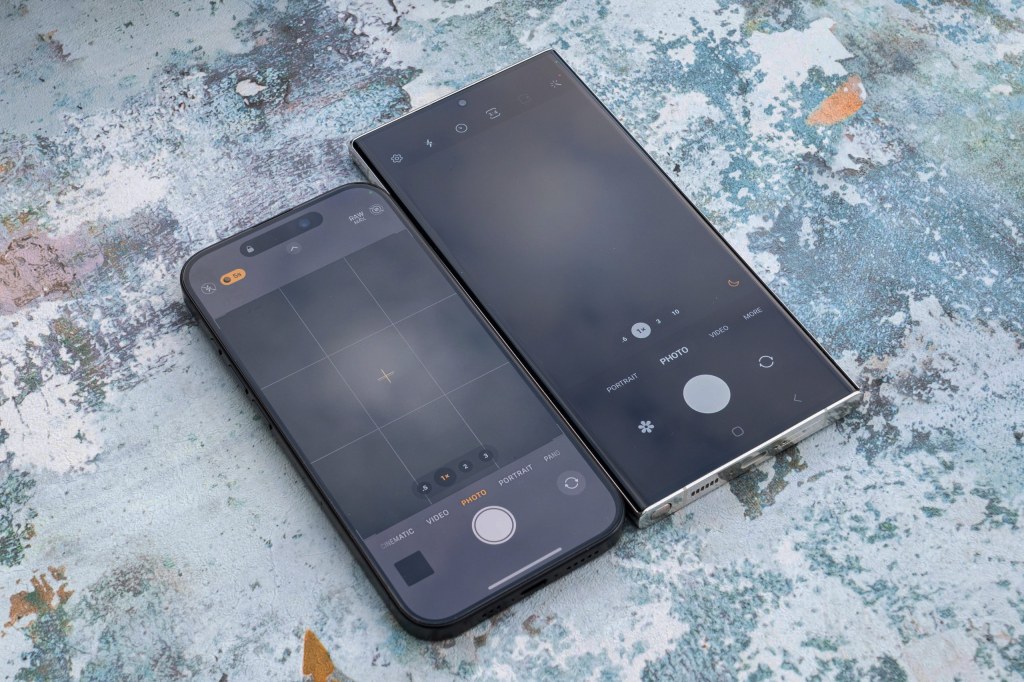
The native camera apps of both models Image credit: Amy Davies
A new feature for the iPhone 15 series is automatic portrait recognition. This means you don’t need to head into the Portrait mode in order for the phone to recognise a portrait subject (human, dog or cat) and record all the information it needs. You can then transform a picture into a portrait (give it a shallow depth of field) after the fact, or remove it if you don’t like it. There is also a dedicated Portrait mode too, where you get more options, such as different lighting setups.
Night mode is something which you can’t control – it’ll come on automatically if it detects low light, and the same is true for the macro focusing, which will work if you bring the phone very close to a subject.
For video, we’ve got a standard Video mode, plus options such as Cinematic, Action, Slow-Mo and Time-Lapse.
If you want a huge degree of control, then the S23 Ultra gives you lots of different options. The standard Photo mode will automatically recognise certain situations, such as low light and macro – but it won’t automatically shoot portraits. There’s specific shooting modes for things like Food and Night, and there’s not one but two manual modes – Pro and ExpertRAW. With these you can adjust things like shutter speed, white balance, and more so if you want complete freedom then it’s super useful. These are also the only modes where you can shoot in raw format – I’d probably like to see raw in the normal Photo mode for after-the-fact editing, though.
When it comes to video, we’ve got a standard video shooting mode, plus there’s a portrait video mode, hyperlapse, slow motion and again more advanced options such as Pro Video and “Director’s View”.
Picking a winner here depends largely on what you want to do with your phone. If you’re keen for ultimate control, it has to be the Samsung. If you prefer simplicity and automation, then probably the iPhone is more suited to you.
iPhone 15 Pro vs Samsung Galaxy S23 Ultra: General image quality
Both the iPhone and the Samsung are capable of taking fantastic photos in a range of conditions, but as usual, we see the best results in good light.
There’s a good degree of detail recorded by both, with the 200MP main sensor of the S23 Ultra doing a great job, demonstrating perhaps slightly finer detail if you examine closely – bear in mind that the standard output for this phone is 12MP even with that large sensor. With the iPhone 15 Pro, the standard output from its 48MP sensor is 24MP, so you’ve got a bit more room to crop after the fact if you need to perhaps.

An image shot with the S23 Ultra – the sky is a little more vibrant than reality Image credit: Amy Davies

The same scene shot with the iPhone 15 Pro is a bit more muted – but also more realistic. Image credit: Amy Davies
Colours are good from both models, but we can see that in some situations – such as blue skies – the S23 Ultra has a tendency to oversaturate. Lots will like this look, but it’s not as realistic as the iPhone version. The overall exposure is a bit darker from the iPhone too, which again is closer to reality. The colours between the lenses for each model are relatively well matched, meaning that you get the same no matter which you use if standing in the same position – which is good news.

The iPhone 15 Pro under mixed lighting. Image credit: Amy Davies

The same shot with the S23 Ultra, where the tones are a lot more yellowish Image credit: Amy Davies
Under artificial lighting, or scenes where mixed lighting is present, the Samsung S23 Ultra tends to err a little bit towards yellowish / warm tones. In isolation this doesn’t look bad, but if you put it next to the iPhone’s version, we can see that the 15 Pro is just a bit more realistic.
Which is best here – that’s a tough one. Both are excellent – but if you’re looking for realism, then the iPhone edges it just about. Perhaps we’ll see more of a stark contrast if we look at specific shooting scenarios….
iPhone 15 Pro vs Samsung Galaxy S23 Ultra: Zoom
If getting closer to the subject is something you’re keen to do, then it should be relatively obvious that the S23 Ultra is going to be the winner here.
You get 10x optical shooting with the S23 Ultra, and a much more staid 3x with the iPhone 15 Pro. You can shoot at 10x digital with the iPhone 15 Pro, but you won’t get such good results – as we can see here.

An image shot at 10x digital zoom with the iPhone 15 Pro. Image credit: Amy Davies

The S23 Ultra has a 10x optical zoom, giving you usable results. Image credit: Amy Davies
It’s quite clear to see that at 10x digital, the iPhone’s image is very inferior to the S23 Ultra’s optical version, which has much more detail and is actually usable as an image – the best we can say about the iPhone’s is that you could use it as a record shot if you can’t physically get closer to the subject.

The maximum digital reach of the iPhone 15 Pro is 15x. Image credit: Amy Davies
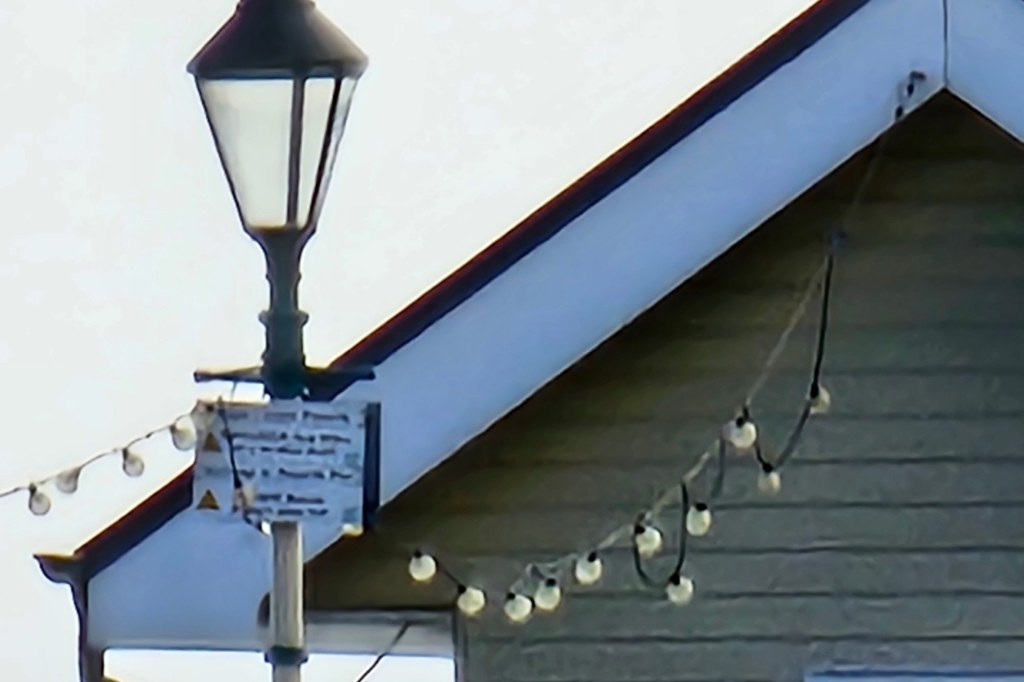
The maximum digital reach of the S23 Ultra is 100x. Image credit: Amy Davies
Going beyond that, you’ve also got digital options. The maximum for the iPhone is 15x, which as you might expect is only about as useful as the 10x. The Samsung offers 100x space zoom, but by and large that’s just a marketing gimmick – as you can see here, although impressively close, it’s not a particularly good image, with lots of smudging.
iPhone 15 Pro vs Samsung Galaxy S23 Ultra: Low light
With both of these phones, if low light is detected, the night mode should automatically activate. With the Samsung however, you can also manually switch it on, which can be helpful in situations where there’s mixed lighting which might confuse the phone.
As we can see in our following two images, the iPhone’s night mode didn’t activate – and so while there’s good detailed exposure on the building, the sky and the surroundings have been lost. Compare it to the S23 Ultra picture and you can clearly see the benefits of Night mode.
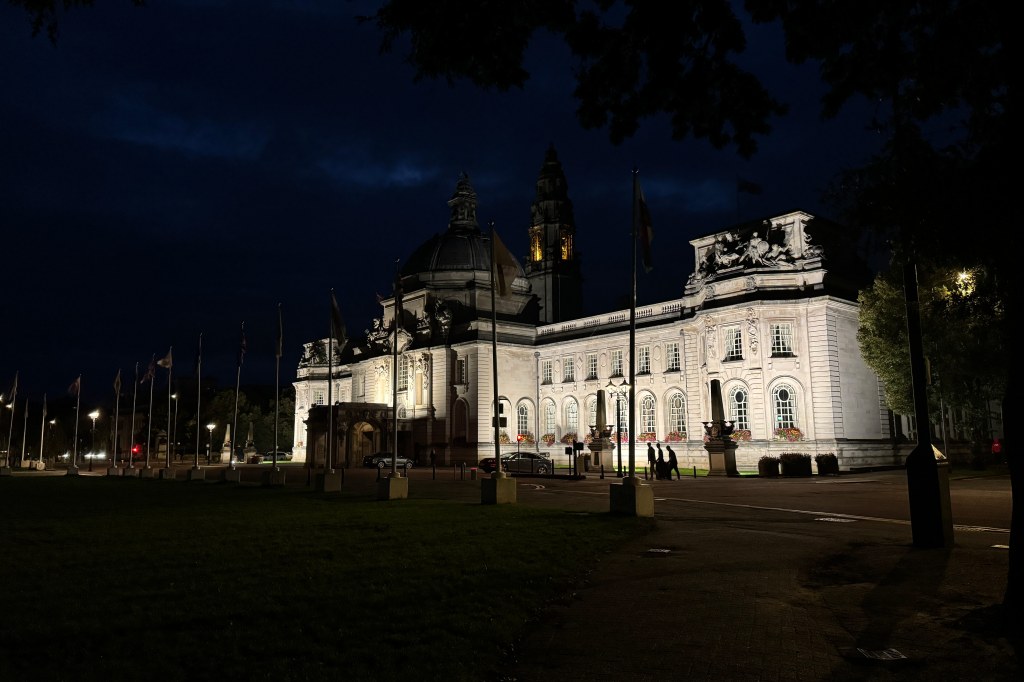
The iPhone 15 Pro’s Night Mode didn’t activate here. Image credit: Amy Davies

The S23 Ultra’s result is much better. Image credit: Amy Davies
When Night mode activates, the results are a bit closer, but the S23 Ultra is still a touch nicer overall, with better colours, slightly more detail and a more balanced exposure. The iPhone 15 Pro is still very good, though.
Here it’s the Samsung which is the clear winner, with the ability to manually activate it being a big benefit.
iPhone 15 Pro vs Samsung Galaxy S23 Ultra: Macro
If you want to get close-up shots, both of these models are good choices. Both have an automatic macro mode that should trigger if you get very close to a subject. For both models, it works by switching to the ultrawide angle lens, but you are losing the ability to record in very high resolutions on either device.
Sometimes, you might find it beneficial to switch off the macro mode, such as if you don’t need to get super close, which is a good way to go back to using higher resolutions.
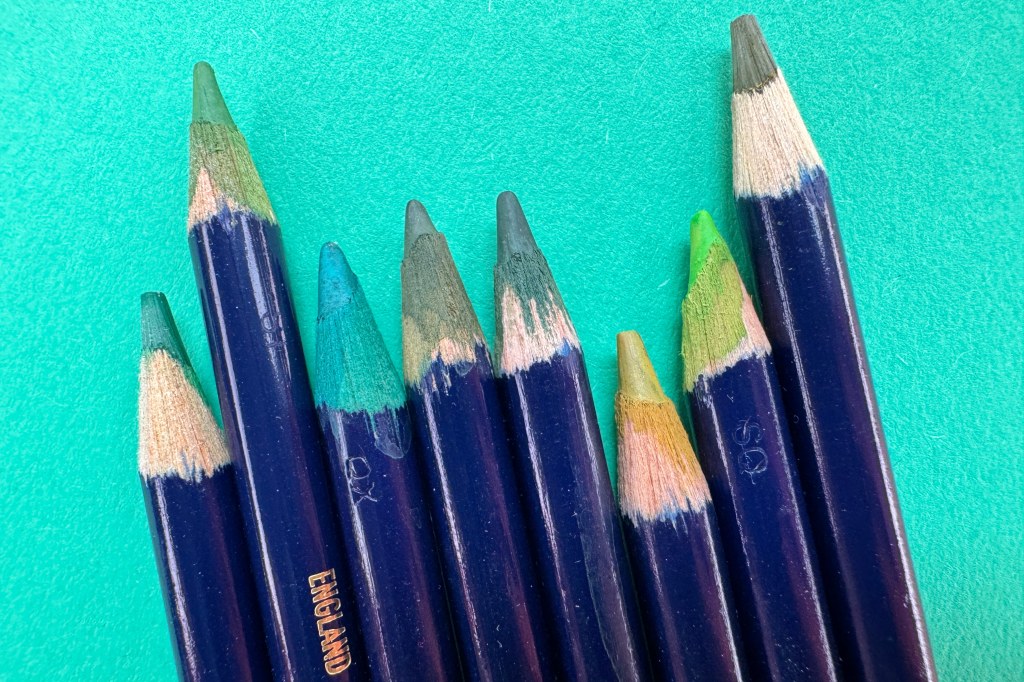
An iPhone 15 Pro macro image. Image credit: Amy Davies
Here, I was practically on top of the pencils in with either of the phones – I was almost touching them. Both put in a great performance, but the Samsung has a touch more detail, and it’s also a little more vibrant. That said, the iPhone’s is still very good and the colours are probably truer to life than the Samsung’s.
Overall, this is a bit of a tie – both are great for this kind of work.
iPhone 15 Pro vs Samsung Galaxy S23 Ultra: Portraits and selfies
A very useful new feature of the iPhone 15 series is its ability to automatically recognise portrait subjects (humans, dogs and cats). You can also shoot in a specific portrait mode. While the S23 Ultra doesn’t benefit from the automatic recognition, it does have a well-featured Portrait mode.
After you’ve shot your portraits, with either model, you have the ability to change the focus point or to adjust the strength of blur.

iPhone 15 Pro Portrait Mode (3x). Image credit: Amy Davies

S23 Ultra Portrait Mode (3x). Image credit: Amy Davies
With the iPhone 15 Pro, you can shoot portraits at either 1x, 2x or 3x, depending on how much background you want to include. For the S23 Ultra, you can have either 1x or 3x. Both produce good results, but the iPhone’s is slightly more natural, with a better fall-off between the subject and the background, and more flattering colours.

Night Portrait mode with the iPhone 15 Pro. Credit: Amy Davies

Night portrait shot with the S23 Ultra. Photo Amy Davies.
Both phones also have the ability to blend Night mode and Portrait mode, which is great for photographing people in low-light. Here, we see the best results using the 1x lens from either device, with both being quite evenly matched in terms of results. The iPhone has a bit more detail, but the Samsung is probably more flattering here.
For selfies, both are pretty good, and both give you options to blur out the background. The S23 Ultra has produced a warmer, less-realistic image though, so I’d probably give the iPhone the edge here.

The Samsung S23 Ultra selfie mode. Photo Amy Davies
Of all the specific shooting modes, it’s Portraits where the iPhone produces better results. It’s a bit more natural, and the automatic portrait recognition is a very useful feature.
iPhone 15 Pro vs Samsung Galaxy S23 Ultra Video:
Video creators might be tempted by either of these models, with both the 15 Pro and the S23 Ultra having great video specifications. The biggest difference however is perhaps the 8K option you’ll get with the S23 Ultra – if that’s something you need (or more likely, want), then it’s that one you need to go for.
For most users, 4K or Full HD will be all they use, so we looked closely at those. Both produce great results at 4K/60fps – though it’s worth noting that from the S23 Ultra, you can’t move between the lenses while shooting at that resolution/frame rate, while you can with the iPhone 15 Pro.
Either has additional stabilisation modes, with the S23 Ultra using “SuperSteady” and the iPhone having an “Action Mode”, both of which you sacrifice the highest recording quality to use. Both models stabilise ordinary videos as standard too.
Other video functions include a shallow depth of field video option for both models (Cinematic for the iPhone, and Portrait Video for the Samsung).
More advanced control can be found with the S23 Ultra, which has a pro video shooting mode. If you’re an advanced vlogger, this might be the more appealing prospect for that reason. You can also of course zoom further with the S23 Ultra, which might also just edge it for you.
For video work, both are great, but the S23 Ultra has more flexibility and a better zoom, so it’s probably that which should win here.
iPhone 15 Pro vs Samsung Galaxy S23 Ultra: Screen and design
Here’s where we see a divergence in specs again – with the iPhone 15 Pro being a relatively small device for a flagship, and the S23 Ultra being bigger than most. Which is better is ultimately down to personal preference.
The iPhone 15 Pro has a 6.1” screen, while the S23 Ultra’s is 6.8”. The benefit of the bigger screen is that videos and photos look great on it, but it can be quite difficult to use for other tasks – particularly if you have smaller hands. Samsung does have a smaller flagship, the Samsung Galaxy S23, but with that, you lose a decent amount of functionality, including the fourth lens and macro shooting. We’ve compared the iPhone 15 Pro and the Samsung S23 to see which of those comes out on top, too.
For the iPhone 15 Pro, you get a Super Retina XDR OLED screen with 2556 x 1179 pixels, compared to the Dynamic AMOLED screen of the S23 Ultra, with 3088 x 1440 pixels. Both look great and display your pictures extremely well – but it’s hard to deny that the bigger size of the S23 Ultra really makes them pop. That said, the iPhone screen is a bit brighter.
Design-wise, which you prefer out of these two – aside from screen size – is again down to personal preferences. Both benefit from “tough” credentials – the Samsung has Corning Gorilla Glass Victus 2, while the iPhone has a Ceramic Shield, which it claims is the toughest on the market. Both withstand scratches on the front quite easily – though some argue that the back of the iPhone smashes a little more readily than the Samsung if you bend them quite hard (not something I have tried myself).
It’s hard to pick a “winner” here, since both models are so different. The simple answer is, if you want a smaller flagship, the iPhone 15 Pro is the one for you, but if you prefer a larger device, the S23 Ultra is better.
iPhone 15 Pro vs Samsung Galaxy S23 Ultra: Battery life, charging and storage
Another benefit of a larger device is that you get additional battery power. The S23 Ultra has a huge 5000mAh battery. The iPhone 15 Pro’s battery size is not disclosed by Apple, but we do know it has 23 hours of video playback, compared to Samsung’s 26 hour quoted battery life.
In real-world/normal usage, you should get a full day’s use out of both models, unless you’re doing something particularly power draining. With the S23 Ultra you might be able to push it to two full days however, something which is much less likely with the iPhone 15 Pro.
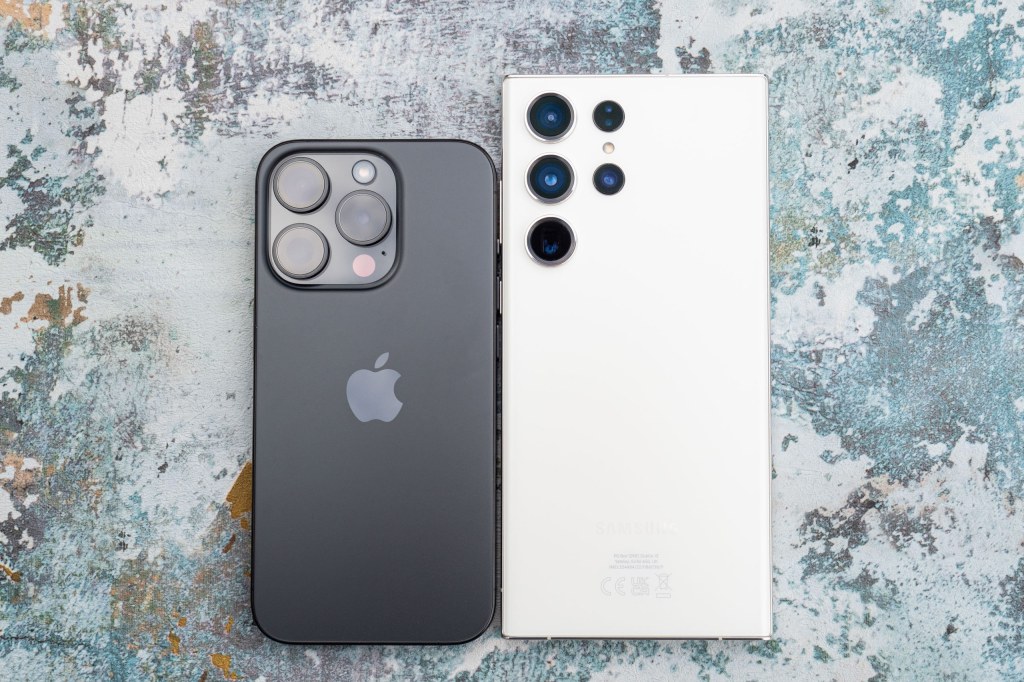
The larger S23 Ultra has a bigger battery than the iPhone 15 Pro. Image credit: Amy Davies
Both use USB-C charging, and both give you the option to use fast charging or wireless charging. Neither comes with a charging plug in the box however, so whatever charging method you prefer, you’ll need to invest in separate devices.
Storage wise, the base option for the iPhone 15 Pro is 128GB, while for the S23 Ultra it’s 256GB. This is likely more than enough for most average users, but if you want more, you can go up to 1TB for either model – paying an appropriate price lift for the privilege.
iPhone 15 Pro vs Samsung Galaxy S23 Ultra: Price
Neither of these models are what we might call cheap, but the iPhone 15 Pro is the cheaper option by quite a margin.
The cheapest you can buy an iPhone 15 Pro is $999/£999, while the cheapest price for the S23 Ultra is $1199/£1249 – though you do get 256GB for that price. The iPhone 15 Pro at 256GB is $1099/£1099 so it’s still the cheaper option.

The iPhone 15 Pro is the cheaper option. Image credit: Amy Davies
If you want the maximum 1TB storage option, then you’ll pay $1499/£1499 for the iPhone 15 Pro, or $1619/£1599 for the S23 Ultra – again the iPhone is the cheaper option here.
These are just the recommended retail prices – you might find that the S23 Ultra, being older, has better second-hand deals available already.
iPhone 15 Pro vs Samsung Galaxy S23 Ultra: Verdict
There are a number of ways to consider a “winner” in a comparison like this. There’s image quality, screen size, price (value for money) and perhaps more things besides.
If we look purely at image quality, then the S23 Ultra is overall the better choice. It has more zoom functionality and does better at night. However, it’s also true to say that the iPhone’s portrait mode is slightly better, and overall images are generally more realistic.
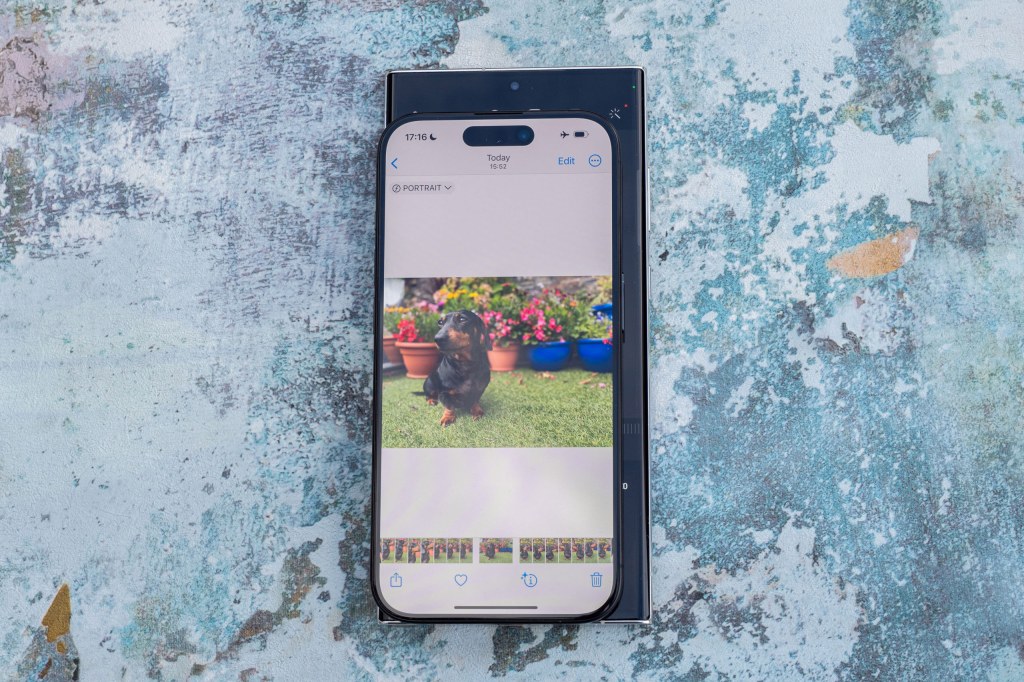
The iPhone 15 Pro sitting on top of the Samsung S23 Ultra. Image credit: Amy Davies
Screen size is something that is down to the individual. The S23 Ultra’s is “better” if you assume that the bigger screen size is better, but if you want something more pocket-friendly yet still powerful, then it’s not much use – the S23 just isn’t quite as up to scratch as the Ultra version.
So that leaves us with pricing / value for money. There’s no getting around both phones being expensive, but the iPhone 15 Pro is still cheaper – you get less screen size for your money, but you keep most of the camera’s prowess, so that’s a good thing.
Picking a winner here is very hard. Overall it’s probably the Samsung Galaxy S23 Ultra, since we are a photography site, but, it’s an extremely closely run thing – which would be your choice?
Further reading:
- Samsung Galaxy S23 Ultra vs Samsung Galaxy S23
- iPhone 15 Pro vs Samsung S23: Battle of the small flagships
- iPhone 14 Pro vs Samsung S23 Ultra: Cameras compared
Follow AP on Facebook, Twitter, Instagram, YouTube and TikTok.

